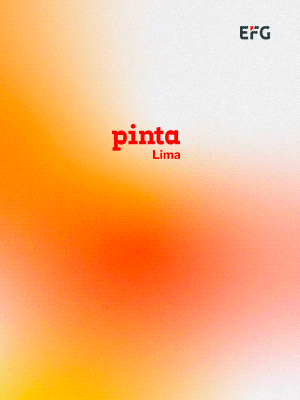RUBÉN ORTIZ-TORREZ AND THE CULTURAL PARADOXES OF THE GLOBALIZED WORLD
The Miriam and Ira D. Wallach Art Gallery at Columbia University presents Rubén Ortiz-Torres: Zonas de Colaboración, the artist’s first major solo exhibition in New York, curated by Betti-Sue Hertz.
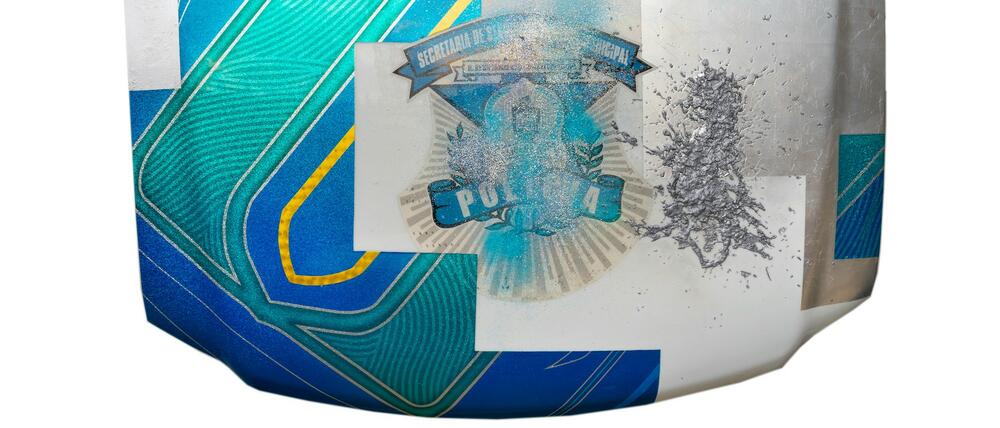
A Mexican artist, writer, and curator based in Los Angeles, Rubén Ortiz-Torres shares a critical, cosmopolitan, technically inventive, and intellectually comic visual practice that explores the cultural paradoxes of our globalized world through the informed convergence of popular and modernist art traditions. Examining recent histories, sometimes disassembling their chronologies or ideologies, Ortiz-Torres recontextualizes and remakes well-known iconographies by collapsing their hierarchies.
When he quotes a scene, Ortiz-Torres redistributes the individual signifiers within it. He takes artistic license and does not claim autonomous authorship yet emphatically claims originality. His radically personal desire for artistic freedom is served by his astute sense of history, whether compiling the outward-looking cacophonous collages of his tile murals or rendering the likenesses of friends on plates, hunting down and photographing Machu Picchu murals in Peruvian restaurants, or making a strange marriage between damaged Tijuana police cars and feminist “glitter” protests. His is an intense practice of observations and internalizations—of social relationships, historical notes, and passions.
-
Rubén Ortiz-Torres, Glitter Protest on Door, 2020. Urethane, candy paint, flake, and holographic flake on decommissioned Tijuana Police car panel, 48 x 62 x 5 inches. Courtesy of Wallach Art Gallery
-
Rubén Ortiz-Torres, Glitter Protest on Door, 2020. Urethane, candy paint, flake, and holographic flake on decommissioned Tijuana Police car panel, 48 x 62 x 5 inches. Courtesy of Wallach Art Gallery
-
Rubén Ortiz-Torres, Gold Glove, 2024. Gold-glazed stoneware, 19.6 x 23.1 x 20.2 cm, Cerámica Suro, Taller Nodo, Guadalajara. Courtesy of Wallach Art Gallery
-
Rubén Ortiz-Torres, Comala Bandit Selfie, 2024. Glazed stoneware, 31.5 cm x 31.5 cm, Guadalajara, Cerámica Suro. Courtesy of Wallach Art Gallery
The city’s raw violence are rendered in drawings on plates based on the CCTV footage of the suspects and tilework adaptations of wanted posters plastered throughout the neighborhood. This series, El Corrido de Leandro Valle (2023), offers visual versions of corridos, a traditional genre of Mexican ballads often associated with the experiences of working-class groups or stories about the daily life of criminals, oppression, or history.
Ortiz-Torres’s work borrows from myriad sources and re-situates cultural symbols and sentiments to bridge disparate references. He gets inside the realities these iconographies represent and locates their emotional registers. The chaotic imagery in two tile murals, Apocalypse Now (2024) and Para todo mal (2024), is derived from depictions in mass media of current wars and ongoing conflicts—tanks in Ukraine, a destroyed mosque in Gaza, ruined apartment buildings, missiles, and the US/Mexico border wall in Tijuana. Constructed as if a mélange of converging corridos, these works feed on the destructive forces in the news that comprise our daily diet of crisis and collapse. The artist’s seeming obsession with originals and copies, re-creations, and quotations, resuscitates instances of history and cultural objects that could have easily gotten lost in the sea of images and events we regularly navigate. Appropriation and simulacra are mobilizing tools for his artmaking.
-
Rubén Ortiz-Torres, Chota, Cholos, and Narcos, 2020. Silverleaf, urethane, lead, candy paint, and flake on decommissioned Tijuana Police car panel, 48 x 62 x 5 inches. Courtesy of Wallach Art Gallery
-
Rubén Ortiz-Torres, ¡Viva el mole de guajolote!, 2024. Glazed stoneware, 30 x 30 cm, Cerámica Suro, Guadalajara. Courtesy of Wallach Art Gallery
-
Rubén Ortiz-Torres, No Me Chinguen, Taller Mexicano de Gobelino, Guadalajara. Courtesy of Wallach Art Gallery
-
Rubén Ortiz-Torres, Chota, Cholos, and Narcos, 2020. Silverleaf, urethane, lead, candy paint, and flake on decommissioned Tijuana Police car panel, 48 x 62 x 5 inches. Courtesy of Wallach Art Gallery
American Graffiti, an animation and related prints, is a tribute to David Alfaro Siqueiros’s 82-foot fresco mural, América Tropical: Oppressed and Destroyed by Imperialism, created in 1932, for an exterior wall of the Italian Hall in Los Angeles. The central figure, an Indigenous man on a cross, was obscured in the original proposal and sparked outrage when the completed work was revealed. The mural was whitewashed soon after. Ortiz-Torres’s intervention into this history begins with an extant black and white image of the mural that slowly becomes obliterated by graffiti and street art in varied styles until the image is transformed into a white blank.
Rubén Ortiz-Torres: Zonas de Colaboración Will be on display until March 16, 2025, at The Miriam and Ira D. Wallach Art Gallery, Lenfest Center for the Arts 615 West 129th Street, New York (United States).
Related Topics
May interest you
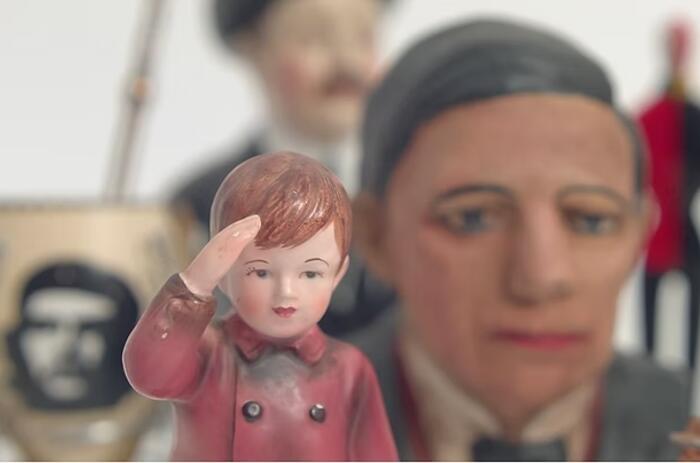
A new group exhibition brings together 17 Argentine artists in New York. Curated by The Bureau of The Unknown Curator, the show features Cecilia Biagini, Ivana Brenner, Rafael Bueno, Bibi Calderaro, Beto De Volder, Dolores Furtado, Julio Grinblatt, Nicolás Guagnini, Claudia Kaatziza Cortínez, Syd Krochmalny, Fabián Marcaccio, Sabrina Merayo Núñez, Luciana Pinchiero, Liliana Porter, Sofía Quirno, Analia Segal, and Pedro Wainer.
THE ARGENTINE INTERNATIONAL AT THE SLIP GALLERY
A new group exhibition brings together 17 Argentine artists in New York. Curated by The Bureau of The Unknown Curator, the show features Cecilia Biagini, Ivana Brenner, Rafael Bueno, Bibi Calderaro, Beto De Volder, Dolores Furtado, Julio Grinblatt, Nicolás Guagnini, Claudia Kaatziza Cortínez, Syd Krochmalny, Fabián Marcaccio, Sabrina Merayo Núñez, Luciana Pinchiero, Liliana Porter, Sofía Quirno, Analia Segal, and Pedro Wainer.

A new group exhibition brings together 17 Argentine artists in New York. Curated by The Bureau of The Unknown Curator, the show features Cecilia Biagini, Ivana Brenner, Rafael Bueno, Bibi Calderaro, Beto De Volder, Dolores Furtado, Julio Grinblatt, Nicolás Guagnini, Claudia Kaatziza Cortínez, Syd Krochmalny, Fabián Marcaccio, Sabrina Merayo Núñez, Luciana Pinchiero, Liliana Porter, Sofía Quirno, Analia Segal, and Pedro Wainer.
THE ARGENTINE INTERNATIONAL AT THE SLIP GALLERY
A new group exhibition brings together 17 Argentine artists in New York. Curated by The Bureau of The Unknown Curator, the show features Cecilia Biagini, Ivana Brenner, Rafael Bueno, Bibi Calderaro, Beto De Volder, Dolores Furtado, Julio Grinblatt, Nicolás Guagnini, Claudia Kaatziza Cortínez, Syd Krochmalny, Fabián Marcaccio, Sabrina Merayo Núñez, Luciana Pinchiero, Liliana Porter, Sofía Quirno, Analia Segal, and Pedro Wainer.

The Center for Art, Research and Alliances (CARA) spring 2025 exhibition, continents like seeds, brings together the work of La Chola Poblete (b. 1989, Argentina), Niño de Elche (b. 1985, Spain), and Pedro G. Romero (b. 1964, Spain); through sound, sculpture, performance, drawing, and painting, the show unravels and exposes the contradictions and ambiguities of colonial legacies.
QUESTIONING TRADITIONS AT CARA
The Center for Art, Research and Alliances (CARA) spring 2025 exhibition, continents like seeds, brings together the work of La Chola Poblete (b. 1989, Argentina), Niño de Elche (b. 1985, Spain), and Pedro G. Romero (b. 1964, Spain); through sound, sculpture, performance, drawing, and painting, the show unravels and exposes the contradictions and ambiguities of colonial legacies.
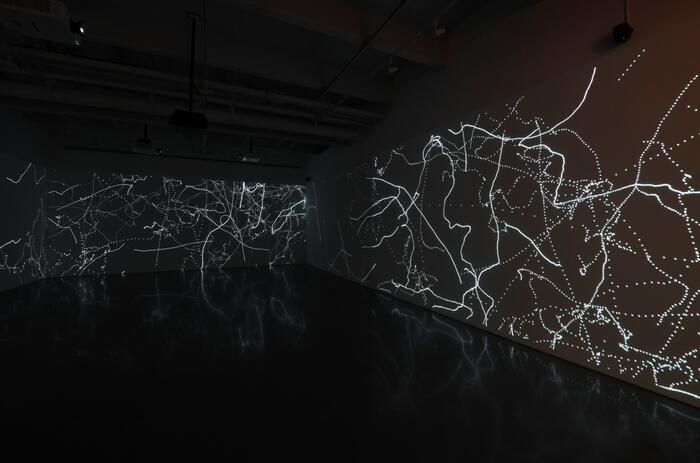
CORRESPONDENCES at Kurimanzutto, the ongoing collaboration between Soundwalk Collective and Patti Smith, marks the first time this body of work is exhibited in New York and in a gallery space; the exhibition explores diverse geographies, histories, and natural environments.
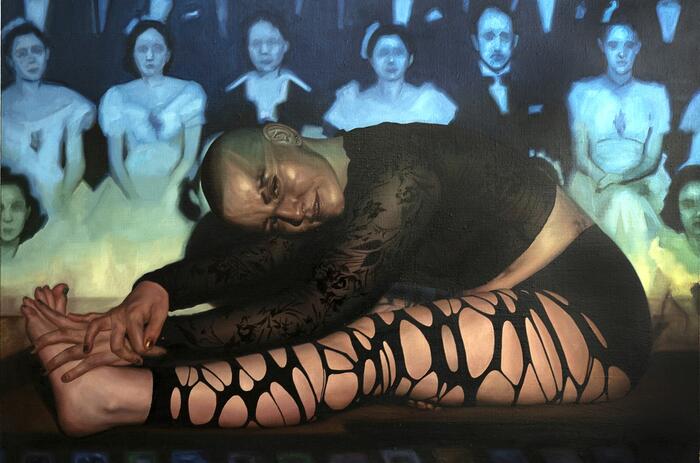
In her work, using traditional techniques such as oil painting, she explores contemporary imaginaries with a reflective approach to the relationship between memory, the body, image, and identity.
ELENA MANERO: PROJECTIONS OF THE UNGRASPABLE MEMORY
In her work, using traditional techniques such as oil painting, she explores contemporary imaginaries with a reflective approach to the relationship between memory, the body, image, and identity.
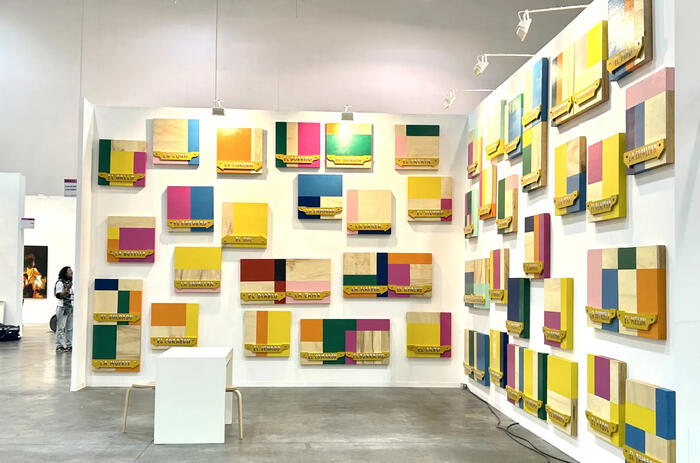
The Mexican art scene is going through an exceptional moment. There is a palpable energy, with new galleries opening, others already consolidated in the process of expansion and Mexican artists and curators gaining more and more international visibility. Their presence in museums, biennials and global fairs continues to grow, consolidating Mexico as a key player in the contemporary art scene.
MEXICO CITY ART WEEK: A VIBRANT SHOWCASE OF THE COUNTRY´S THRIVING ART SCENE
The Mexican art scene is going through an exceptional moment. There is a palpable energy, with new galleries opening, others already consolidated in the process of expansion and Mexican artists and curators gaining more and more international visibility. Their presence in museums, biennials and global fairs continues to grow, consolidating Mexico as a key player in the contemporary art scene.
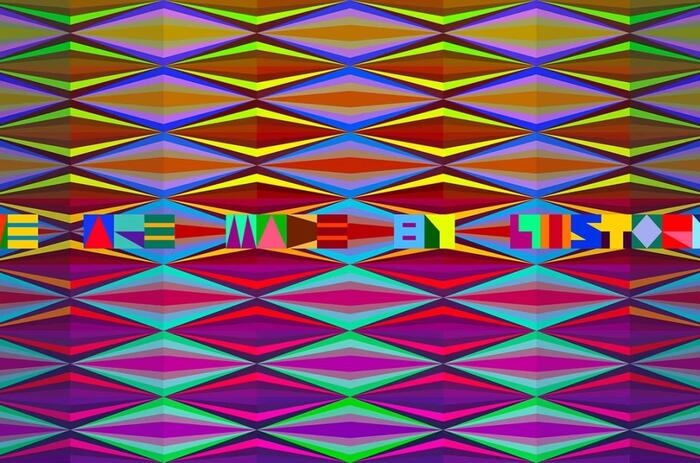
The Broad Museum is set to present Jeffrey Gibson: the space in which to place me, a special exhibition showcasing the artist’s multidimensional work. Adapted from its original presentation at the U.S. Pavilion at the 60th Biennale in 2024, this exhibition marks a historic moment—Gibson was the first Indigenous artist to represent the United States with a solo exhibition.
JEFFREY GIBSON IN LOS ANGELES: A KALEIDOSCOPE OF IDENTITY AND RESISTANCE
The Broad Museum is set to present Jeffrey Gibson: the space in which to place me, a special exhibition showcasing the artist’s multidimensional work. Adapted from its original presentation at the U.S. Pavilion at the 60th Biennale in 2024, this exhibition marks a historic moment—Gibson was the first Indigenous artist to represent the United States with a solo exhibition.
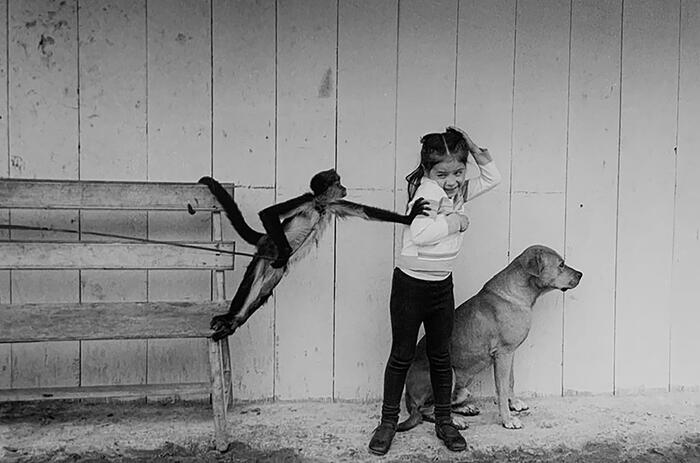
Paths of Life invites viewers on a journey through 45 years of the Mexican photographer's distinguished photographic career; the exhibition presents a captivating combination of previously unpublished images from the artist's personal archive along with her most recent works.
FLOR GARDUÑO AT FOTOFEST´S SPRING SHOWCASE
Paths of Life invites viewers on a journey through 45 years of the Mexican photographer's distinguished photographic career; the exhibition presents a captivating combination of previously unpublished images from the artist's personal archive along with her most recent works.
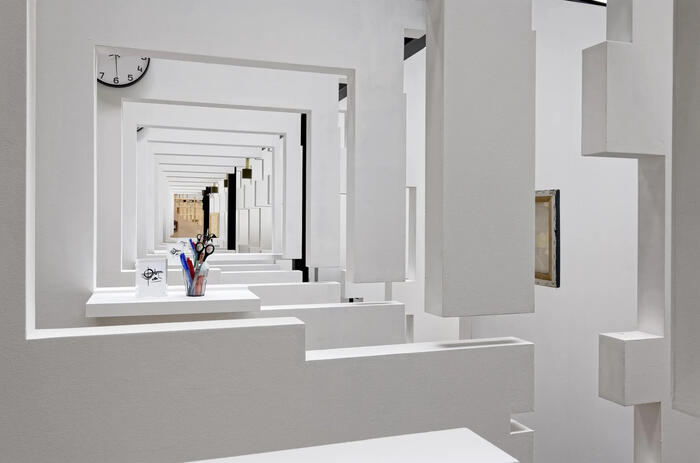
The MIT List Visual Arts Center presents The Great Learning, Pedro Gómez-Egaña’s exhibition that materializes our polyrhythmic experiences of time.
PEDRO GÓMEZ-EGAÑA AND THE MANIFESTATION OF PERCEPTION
The MIT List Visual Arts Center presents The Great Learning, Pedro Gómez-Egaña’s exhibition that materializes our polyrhythmic experiences of time.
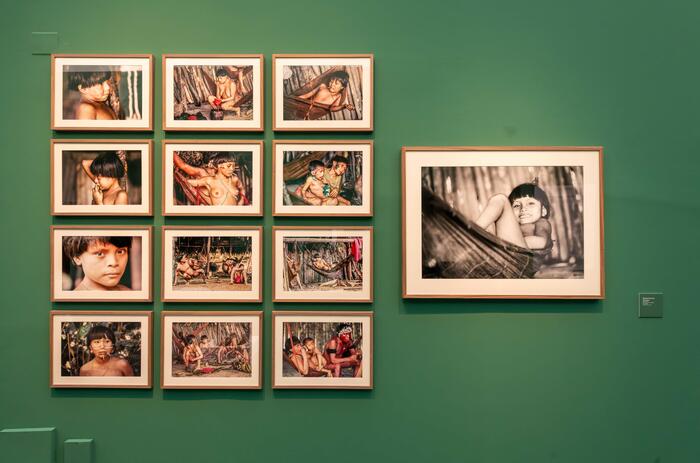
Madrid's CentroCentro approaches the artistic production related to the Amazon with the exhibition Trópico sin tópico: Amazonas (Tropic without Topic: Amazon), curated by Halim Badawi (Barranquilla, Colombia, 1982), and with which it intends to facilitate new looks beyond the usual ones with which the European imaginary contemplates the indigenous legacy and its relation with the contemporary world.
THE REVERSION OF AMAZONIAN CLICHÉS AT CENTROCENTRO
Madrid's CentroCentro approaches the artistic production related to the Amazon with the exhibition Trópico sin tópico: Amazonas (Tropic without Topic: Amazon), curated by Halim Badawi (Barranquilla, Colombia, 1982), and with which it intends to facilitate new looks beyond the usual ones with which the European imaginary contemplates the indigenous legacy and its relation with the contemporary world.

The Museum of Modern and Contemporary Art in Bolzano-Bozen presented a pioneering exhibition on the relationship between graffiti and contemporary art. Curated by Leonie Radine and Ned Vena, the show will be the first in an Italian museum to explore the history of spray paint in art.
GRAFFITI AT MUSEION
The Museum of Modern and Contemporary Art in Bolzano-Bozen presented a pioneering exhibition on the relationship between graffiti and contemporary art. Curated by Leonie Radine and Ned Vena, the show will be the first in an Italian museum to explore the history of spray paint in art.

A new group exhibition brings together 17 Argentine artists in New York. Curated by The Bureau of The Unknown Curator, the show features Cecilia Biagini, Ivana Brenner, Rafael Bueno, Bibi Calderaro, Beto De Volder, Dolores Furtado, Julio Grinblatt, Nicolás Guagnini, Claudia Kaatziza Cortínez, Syd Krochmalny, Fabián Marcaccio, Sabrina Merayo Núñez, Luciana Pinchiero, Liliana Porter, Sofía Quirno, Analia Segal, and Pedro Wainer.
THE ARGENTINE INTERNATIONAL AT THE SLIP GALLERY
A new group exhibition brings together 17 Argentine artists in New York. Curated by The Bureau of The Unknown Curator, the show features Cecilia Biagini, Ivana Brenner, Rafael Bueno, Bibi Calderaro, Beto De Volder, Dolores Furtado, Julio Grinblatt, Nicolás Guagnini, Claudia Kaatziza Cortínez, Syd Krochmalny, Fabián Marcaccio, Sabrina Merayo Núñez, Luciana Pinchiero, Liliana Porter, Sofía Quirno, Analia Segal, and Pedro Wainer.

The Center for Art, Research and Alliances (CARA) spring 2025 exhibition, continents like seeds, brings together the work of La Chola Poblete (b. 1989, Argentina), Niño de Elche (b. 1985, Spain), and Pedro G. Romero (b. 1964, Spain); through sound, sculpture, performance, drawing, and painting, the show unravels and exposes the contradictions and ambiguities of colonial legacies.
QUESTIONING TRADITIONS AT CARA
The Center for Art, Research and Alliances (CARA) spring 2025 exhibition, continents like seeds, brings together the work of La Chola Poblete (b. 1989, Argentina), Niño de Elche (b. 1985, Spain), and Pedro G. Romero (b. 1964, Spain); through sound, sculpture, performance, drawing, and painting, the show unravels and exposes the contradictions and ambiguities of colonial legacies.

CORRESPONDENCES at Kurimanzutto, the ongoing collaboration between Soundwalk Collective and Patti Smith, marks the first time this body of work is exhibited in New York and in a gallery space; the exhibition explores diverse geographies, histories, and natural environments.

In her work, using traditional techniques such as oil painting, she explores contemporary imaginaries with a reflective approach to the relationship between memory, the body, image, and identity.
ELENA MANERO: PROJECTIONS OF THE UNGRASPABLE MEMORY
In her work, using traditional techniques such as oil painting, she explores contemporary imaginaries with a reflective approach to the relationship between memory, the body, image, and identity.

The Mexican art scene is going through an exceptional moment. There is a palpable energy, with new galleries opening, others already consolidated in the process of expansion and Mexican artists and curators gaining more and more international visibility. Their presence in museums, biennials and global fairs continues to grow, consolidating Mexico as a key player in the contemporary art scene.
MEXICO CITY ART WEEK: A VIBRANT SHOWCASE OF THE COUNTRY´S THRIVING ART SCENE
The Mexican art scene is going through an exceptional moment. There is a palpable energy, with new galleries opening, others already consolidated in the process of expansion and Mexican artists and curators gaining more and more international visibility. Their presence in museums, biennials and global fairs continues to grow, consolidating Mexico as a key player in the contemporary art scene.

The Broad Museum is set to present Jeffrey Gibson: the space in which to place me, a special exhibition showcasing the artist’s multidimensional work. Adapted from its original presentation at the U.S. Pavilion at the 60th Biennale in 2024, this exhibition marks a historic moment—Gibson was the first Indigenous artist to represent the United States with a solo exhibition.
JEFFREY GIBSON IN LOS ANGELES: A KALEIDOSCOPE OF IDENTITY AND RESISTANCE
The Broad Museum is set to present Jeffrey Gibson: the space in which to place me, a special exhibition showcasing the artist’s multidimensional work. Adapted from its original presentation at the U.S. Pavilion at the 60th Biennale in 2024, this exhibition marks a historic moment—Gibson was the first Indigenous artist to represent the United States with a solo exhibition.

Paths of Life invites viewers on a journey through 45 years of the Mexican photographer's distinguished photographic career; the exhibition presents a captivating combination of previously unpublished images from the artist's personal archive along with her most recent works.
FLOR GARDUÑO AT FOTOFEST´S SPRING SHOWCASE
Paths of Life invites viewers on a journey through 45 years of the Mexican photographer's distinguished photographic career; the exhibition presents a captivating combination of previously unpublished images from the artist's personal archive along with her most recent works.

The MIT List Visual Arts Center presents The Great Learning, Pedro Gómez-Egaña’s exhibition that materializes our polyrhythmic experiences of time.
PEDRO GÓMEZ-EGAÑA AND THE MANIFESTATION OF PERCEPTION
The MIT List Visual Arts Center presents The Great Learning, Pedro Gómez-Egaña’s exhibition that materializes our polyrhythmic experiences of time.

Madrid's CentroCentro approaches the artistic production related to the Amazon with the exhibition Trópico sin tópico: Amazonas (Tropic without Topic: Amazon), curated by Halim Badawi (Barranquilla, Colombia, 1982), and with which it intends to facilitate new looks beyond the usual ones with which the European imaginary contemplates the indigenous legacy and its relation with the contemporary world.
THE REVERSION OF AMAZONIAN CLICHÉS AT CENTROCENTRO
Madrid's CentroCentro approaches the artistic production related to the Amazon with the exhibition Trópico sin tópico: Amazonas (Tropic without Topic: Amazon), curated by Halim Badawi (Barranquilla, Colombia, 1982), and with which it intends to facilitate new looks beyond the usual ones with which the European imaginary contemplates the indigenous legacy and its relation with the contemporary world.

The Museum of Modern and Contemporary Art in Bolzano-Bozen presented a pioneering exhibition on the relationship between graffiti and contemporary art. Curated by Leonie Radine and Ned Vena, the show will be the first in an Italian museum to explore the history of spray paint in art.
GRAFFITI AT MUSEION
The Museum of Modern and Contemporary Art in Bolzano-Bozen presented a pioneering exhibition on the relationship between graffiti and contemporary art. Curated by Leonie Radine and Ned Vena, the show will be the first in an Italian museum to explore the history of spray paint in art.

A new group exhibition brings together 17 Argentine artists in New York. Curated by The Bureau of The Unknown Curator, the show features Cecilia Biagini, Ivana Brenner, Rafael Bueno, Bibi Calderaro, Beto De Volder, Dolores Furtado, Julio Grinblatt, Nicolás Guagnini, Claudia Kaatziza Cortínez, Syd Krochmalny, Fabián Marcaccio, Sabrina Merayo Núñez, Luciana Pinchiero, Liliana Porter, Sofía Quirno, Analia Segal, and Pedro Wainer.
THE ARGENTINE INTERNATIONAL AT THE SLIP GALLERY
A new group exhibition brings together 17 Argentine artists in New York. Curated by The Bureau of The Unknown Curator, the show features Cecilia Biagini, Ivana Brenner, Rafael Bueno, Bibi Calderaro, Beto De Volder, Dolores Furtado, Julio Grinblatt, Nicolás Guagnini, Claudia Kaatziza Cortínez, Syd Krochmalny, Fabián Marcaccio, Sabrina Merayo Núñez, Luciana Pinchiero, Liliana Porter, Sofía Quirno, Analia Segal, and Pedro Wainer.

The Center for Art, Research and Alliances (CARA) spring 2025 exhibition, continents like seeds, brings together the work of La Chola Poblete (b. 1989, Argentina), Niño de Elche (b. 1985, Spain), and Pedro G. Romero (b. 1964, Spain); through sound, sculpture, performance, drawing, and painting, the show unravels and exposes the contradictions and ambiguities of colonial legacies.
QUESTIONING TRADITIONS AT CARA
The Center for Art, Research and Alliances (CARA) spring 2025 exhibition, continents like seeds, brings together the work of La Chola Poblete (b. 1989, Argentina), Niño de Elche (b. 1985, Spain), and Pedro G. Romero (b. 1964, Spain); through sound, sculpture, performance, drawing, and painting, the show unravels and exposes the contradictions and ambiguities of colonial legacies.

CORRESPONDENCES at Kurimanzutto, the ongoing collaboration between Soundwalk Collective and Patti Smith, marks the first time this body of work is exhibited in New York and in a gallery space; the exhibition explores diverse geographies, histories, and natural environments.

In her work, using traditional techniques such as oil painting, she explores contemporary imaginaries with a reflective approach to the relationship between memory, the body, image, and identity.
ELENA MANERO: PROJECTIONS OF THE UNGRASPABLE MEMORY
In her work, using traditional techniques such as oil painting, she explores contemporary imaginaries with a reflective approach to the relationship between memory, the body, image, and identity.

The Mexican art scene is going through an exceptional moment. There is a palpable energy, with new galleries opening, others already consolidated in the process of expansion and Mexican artists and curators gaining more and more international visibility. Their presence in museums, biennials and global fairs continues to grow, consolidating Mexico as a key player in the contemporary art scene.
MEXICO CITY ART WEEK: A VIBRANT SHOWCASE OF THE COUNTRY´S THRIVING ART SCENE
The Mexican art scene is going through an exceptional moment. There is a palpable energy, with new galleries opening, others already consolidated in the process of expansion and Mexican artists and curators gaining more and more international visibility. Their presence in museums, biennials and global fairs continues to grow, consolidating Mexico as a key player in the contemporary art scene.

The Broad Museum is set to present Jeffrey Gibson: the space in which to place me, a special exhibition showcasing the artist’s multidimensional work. Adapted from its original presentation at the U.S. Pavilion at the 60th Biennale in 2024, this exhibition marks a historic moment—Gibson was the first Indigenous artist to represent the United States with a solo exhibition.
JEFFREY GIBSON IN LOS ANGELES: A KALEIDOSCOPE OF IDENTITY AND RESISTANCE
The Broad Museum is set to present Jeffrey Gibson: the space in which to place me, a special exhibition showcasing the artist’s multidimensional work. Adapted from its original presentation at the U.S. Pavilion at the 60th Biennale in 2024, this exhibition marks a historic moment—Gibson was the first Indigenous artist to represent the United States with a solo exhibition.

Paths of Life invites viewers on a journey through 45 years of the Mexican photographer's distinguished photographic career; the exhibition presents a captivating combination of previously unpublished images from the artist's personal archive along with her most recent works.
FLOR GARDUÑO AT FOTOFEST´S SPRING SHOWCASE
Paths of Life invites viewers on a journey through 45 years of the Mexican photographer's distinguished photographic career; the exhibition presents a captivating combination of previously unpublished images from the artist's personal archive along with her most recent works.

The MIT List Visual Arts Center presents The Great Learning, Pedro Gómez-Egaña’s exhibition that materializes our polyrhythmic experiences of time.
PEDRO GÓMEZ-EGAÑA AND THE MANIFESTATION OF PERCEPTION
The MIT List Visual Arts Center presents The Great Learning, Pedro Gómez-Egaña’s exhibition that materializes our polyrhythmic experiences of time.

Madrid's CentroCentro approaches the artistic production related to the Amazon with the exhibition Trópico sin tópico: Amazonas (Tropic without Topic: Amazon), curated by Halim Badawi (Barranquilla, Colombia, 1982), and with which it intends to facilitate new looks beyond the usual ones with which the European imaginary contemplates the indigenous legacy and its relation with the contemporary world.
THE REVERSION OF AMAZONIAN CLICHÉS AT CENTROCENTRO
Madrid's CentroCentro approaches the artistic production related to the Amazon with the exhibition Trópico sin tópico: Amazonas (Tropic without Topic: Amazon), curated by Halim Badawi (Barranquilla, Colombia, 1982), and with which it intends to facilitate new looks beyond the usual ones with which the European imaginary contemplates the indigenous legacy and its relation with the contemporary world.

The Museum of Modern and Contemporary Art in Bolzano-Bozen presented a pioneering exhibition on the relationship between graffiti and contemporary art. Curated by Leonie Radine and Ned Vena, the show will be the first in an Italian museum to explore the history of spray paint in art.
GRAFFITI AT MUSEION
The Museum of Modern and Contemporary Art in Bolzano-Bozen presented a pioneering exhibition on the relationship between graffiti and contemporary art. Curated by Leonie Radine and Ned Vena, the show will be the first in an Italian museum to explore the history of spray paint in art.

A new group exhibition brings together 17 Argentine artists in New York. Curated by The Bureau of The Unknown Curator, the show features Cecilia Biagini, Ivana Brenner, Rafael Bueno, Bibi Calderaro, Beto De Volder, Dolores Furtado, Julio Grinblatt, Nicolás Guagnini, Claudia Kaatziza Cortínez, Syd Krochmalny, Fabián Marcaccio, Sabrina Merayo Núñez, Luciana Pinchiero, Liliana Porter, Sofía Quirno, Analia Segal, and Pedro Wainer.
THE ARGENTINE INTERNATIONAL AT THE SLIP GALLERY
A new group exhibition brings together 17 Argentine artists in New York. Curated by The Bureau of The Unknown Curator, the show features Cecilia Biagini, Ivana Brenner, Rafael Bueno, Bibi Calderaro, Beto De Volder, Dolores Furtado, Julio Grinblatt, Nicolás Guagnini, Claudia Kaatziza Cortínez, Syd Krochmalny, Fabián Marcaccio, Sabrina Merayo Núñez, Luciana Pinchiero, Liliana Porter, Sofía Quirno, Analia Segal, and Pedro Wainer.

The Center for Art, Research and Alliances (CARA) spring 2025 exhibition, continents like seeds, brings together the work of La Chola Poblete (b. 1989, Argentina), Niño de Elche (b. 1985, Spain), and Pedro G. Romero (b. 1964, Spain); through sound, sculpture, performance, drawing, and painting, the show unravels and exposes the contradictions and ambiguities of colonial legacies.
QUESTIONING TRADITIONS AT CARA
The Center for Art, Research and Alliances (CARA) spring 2025 exhibition, continents like seeds, brings together the work of La Chola Poblete (b. 1989, Argentina), Niño de Elche (b. 1985, Spain), and Pedro G. Romero (b. 1964, Spain); through sound, sculpture, performance, drawing, and painting, the show unravels and exposes the contradictions and ambiguities of colonial legacies.

CORRESPONDENCES at Kurimanzutto, the ongoing collaboration between Soundwalk Collective and Patti Smith, marks the first time this body of work is exhibited in New York and in a gallery space; the exhibition explores diverse geographies, histories, and natural environments.

In her work, using traditional techniques such as oil painting, she explores contemporary imaginaries with a reflective approach to the relationship between memory, the body, image, and identity.
ELENA MANERO: PROJECTIONS OF THE UNGRASPABLE MEMORY
In her work, using traditional techniques such as oil painting, she explores contemporary imaginaries with a reflective approach to the relationship between memory, the body, image, and identity.

The Mexican art scene is going through an exceptional moment. There is a palpable energy, with new galleries opening, others already consolidated in the process of expansion and Mexican artists and curators gaining more and more international visibility. Their presence in museums, biennials and global fairs continues to grow, consolidating Mexico as a key player in the contemporary art scene.
MEXICO CITY ART WEEK: A VIBRANT SHOWCASE OF THE COUNTRY´S THRIVING ART SCENE
The Mexican art scene is going through an exceptional moment. There is a palpable energy, with new galleries opening, others already consolidated in the process of expansion and Mexican artists and curators gaining more and more international visibility. Their presence in museums, biennials and global fairs continues to grow, consolidating Mexico as a key player in the contemporary art scene.

The Broad Museum is set to present Jeffrey Gibson: the space in which to place me, a special exhibition showcasing the artist’s multidimensional work. Adapted from its original presentation at the U.S. Pavilion at the 60th Biennale in 2024, this exhibition marks a historic moment—Gibson was the first Indigenous artist to represent the United States with a solo exhibition.
JEFFREY GIBSON IN LOS ANGELES: A KALEIDOSCOPE OF IDENTITY AND RESISTANCE
The Broad Museum is set to present Jeffrey Gibson: the space in which to place me, a special exhibition showcasing the artist’s multidimensional work. Adapted from its original presentation at the U.S. Pavilion at the 60th Biennale in 2024, this exhibition marks a historic moment—Gibson was the first Indigenous artist to represent the United States with a solo exhibition.

Paths of Life invites viewers on a journey through 45 years of the Mexican photographer's distinguished photographic career; the exhibition presents a captivating combination of previously unpublished images from the artist's personal archive along with her most recent works.
FLOR GARDUÑO AT FOTOFEST´S SPRING SHOWCASE
Paths of Life invites viewers on a journey through 45 years of the Mexican photographer's distinguished photographic career; the exhibition presents a captivating combination of previously unpublished images from the artist's personal archive along with her most recent works.

The MIT List Visual Arts Center presents The Great Learning, Pedro Gómez-Egaña’s exhibition that materializes our polyrhythmic experiences of time.
PEDRO GÓMEZ-EGAÑA AND THE MANIFESTATION OF PERCEPTION
The MIT List Visual Arts Center presents The Great Learning, Pedro Gómez-Egaña’s exhibition that materializes our polyrhythmic experiences of time.

Madrid's CentroCentro approaches the artistic production related to the Amazon with the exhibition Trópico sin tópico: Amazonas (Tropic without Topic: Amazon), curated by Halim Badawi (Barranquilla, Colombia, 1982), and with which it intends to facilitate new looks beyond the usual ones with which the European imaginary contemplates the indigenous legacy and its relation with the contemporary world.
THE REVERSION OF AMAZONIAN CLICHÉS AT CENTROCENTRO
Madrid's CentroCentro approaches the artistic production related to the Amazon with the exhibition Trópico sin tópico: Amazonas (Tropic without Topic: Amazon), curated by Halim Badawi (Barranquilla, Colombia, 1982), and with which it intends to facilitate new looks beyond the usual ones with which the European imaginary contemplates the indigenous legacy and its relation with the contemporary world.

The Museum of Modern and Contemporary Art in Bolzano-Bozen presented a pioneering exhibition on the relationship between graffiti and contemporary art. Curated by Leonie Radine and Ned Vena, the show will be the first in an Italian museum to explore the history of spray paint in art.
GRAFFITI AT MUSEION
The Museum of Modern and Contemporary Art in Bolzano-Bozen presented a pioneering exhibition on the relationship between graffiti and contemporary art. Curated by Leonie Radine and Ned Vena, the show will be the first in an Italian museum to explore the history of spray paint in art.

A new group exhibition brings together 17 Argentine artists in New York. Curated by The Bureau of The Unknown Curator, the show features Cecilia Biagini, Ivana Brenner, Rafael Bueno, Bibi Calderaro, Beto De Volder, Dolores Furtado, Julio Grinblatt, Nicolás Guagnini, Claudia Kaatziza Cortínez, Syd Krochmalny, Fabián Marcaccio, Sabrina Merayo Núñez, Luciana Pinchiero, Liliana Porter, Sofía Quirno, Analia Segal, and Pedro Wainer.
THE ARGENTINE INTERNATIONAL AT THE SLIP GALLERY
A new group exhibition brings together 17 Argentine artists in New York. Curated by The Bureau of The Unknown Curator, the show features Cecilia Biagini, Ivana Brenner, Rafael Bueno, Bibi Calderaro, Beto De Volder, Dolores Furtado, Julio Grinblatt, Nicolás Guagnini, Claudia Kaatziza Cortínez, Syd Krochmalny, Fabián Marcaccio, Sabrina Merayo Núñez, Luciana Pinchiero, Liliana Porter, Sofía Quirno, Analia Segal, and Pedro Wainer.

The Center for Art, Research and Alliances (CARA) spring 2025 exhibition, continents like seeds, brings together the work of La Chola Poblete (b. 1989, Argentina), Niño de Elche (b. 1985, Spain), and Pedro G. Romero (b. 1964, Spain); through sound, sculpture, performance, drawing, and painting, the show unravels and exposes the contradictions and ambiguities of colonial legacies.
QUESTIONING TRADITIONS AT CARA
The Center for Art, Research and Alliances (CARA) spring 2025 exhibition, continents like seeds, brings together the work of La Chola Poblete (b. 1989, Argentina), Niño de Elche (b. 1985, Spain), and Pedro G. Romero (b. 1964, Spain); through sound, sculpture, performance, drawing, and painting, the show unravels and exposes the contradictions and ambiguities of colonial legacies.

CORRESPONDENCES at Kurimanzutto, the ongoing collaboration between Soundwalk Collective and Patti Smith, marks the first time this body of work is exhibited in New York and in a gallery space; the exhibition explores diverse geographies, histories, and natural environments.

In her work, using traditional techniques such as oil painting, she explores contemporary imaginaries with a reflective approach to the relationship between memory, the body, image, and identity.
ELENA MANERO: PROJECTIONS OF THE UNGRASPABLE MEMORY
In her work, using traditional techniques such as oil painting, she explores contemporary imaginaries with a reflective approach to the relationship between memory, the body, image, and identity.

The Mexican art scene is going through an exceptional moment. There is a palpable energy, with new galleries opening, others already consolidated in the process of expansion and Mexican artists and curators gaining more and more international visibility. Their presence in museums, biennials and global fairs continues to grow, consolidating Mexico as a key player in the contemporary art scene.
MEXICO CITY ART WEEK: A VIBRANT SHOWCASE OF THE COUNTRY´S THRIVING ART SCENE
The Mexican art scene is going through an exceptional moment. There is a palpable energy, with new galleries opening, others already consolidated in the process of expansion and Mexican artists and curators gaining more and more international visibility. Their presence in museums, biennials and global fairs continues to grow, consolidating Mexico as a key player in the contemporary art scene.

The Broad Museum is set to present Jeffrey Gibson: the space in which to place me, a special exhibition showcasing the artist’s multidimensional work. Adapted from its original presentation at the U.S. Pavilion at the 60th Biennale in 2024, this exhibition marks a historic moment—Gibson was the first Indigenous artist to represent the United States with a solo exhibition.
JEFFREY GIBSON IN LOS ANGELES: A KALEIDOSCOPE OF IDENTITY AND RESISTANCE
The Broad Museum is set to present Jeffrey Gibson: the space in which to place me, a special exhibition showcasing the artist’s multidimensional work. Adapted from its original presentation at the U.S. Pavilion at the 60th Biennale in 2024, this exhibition marks a historic moment—Gibson was the first Indigenous artist to represent the United States with a solo exhibition.

Paths of Life invites viewers on a journey through 45 years of the Mexican photographer's distinguished photographic career; the exhibition presents a captivating combination of previously unpublished images from the artist's personal archive along with her most recent works.
FLOR GARDUÑO AT FOTOFEST´S SPRING SHOWCASE
Paths of Life invites viewers on a journey through 45 years of the Mexican photographer's distinguished photographic career; the exhibition presents a captivating combination of previously unpublished images from the artist's personal archive along with her most recent works.

The MIT List Visual Arts Center presents The Great Learning, Pedro Gómez-Egaña’s exhibition that materializes our polyrhythmic experiences of time.
PEDRO GÓMEZ-EGAÑA AND THE MANIFESTATION OF PERCEPTION
The MIT List Visual Arts Center presents The Great Learning, Pedro Gómez-Egaña’s exhibition that materializes our polyrhythmic experiences of time.

Madrid's CentroCentro approaches the artistic production related to the Amazon with the exhibition Trópico sin tópico: Amazonas (Tropic without Topic: Amazon), curated by Halim Badawi (Barranquilla, Colombia, 1982), and with which it intends to facilitate new looks beyond the usual ones with which the European imaginary contemplates the indigenous legacy and its relation with the contemporary world.
THE REVERSION OF AMAZONIAN CLICHÉS AT CENTROCENTRO
Madrid's CentroCentro approaches the artistic production related to the Amazon with the exhibition Trópico sin tópico: Amazonas (Tropic without Topic: Amazon), curated by Halim Badawi (Barranquilla, Colombia, 1982), and with which it intends to facilitate new looks beyond the usual ones with which the European imaginary contemplates the indigenous legacy and its relation with the contemporary world.

The Museum of Modern and Contemporary Art in Bolzano-Bozen presented a pioneering exhibition on the relationship between graffiti and contemporary art. Curated by Leonie Radine and Ned Vena, the show will be the first in an Italian museum to explore the history of spray paint in art.
GRAFFITI AT MUSEION
The Museum of Modern and Contemporary Art in Bolzano-Bozen presented a pioneering exhibition on the relationship between graffiti and contemporary art. Curated by Leonie Radine and Ned Vena, the show will be the first in an Italian museum to explore the history of spray paint in art.

